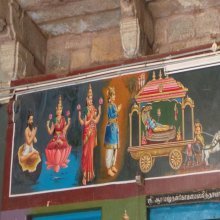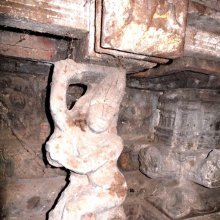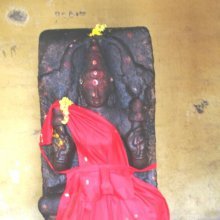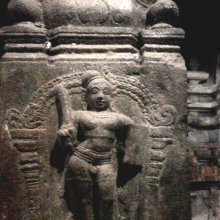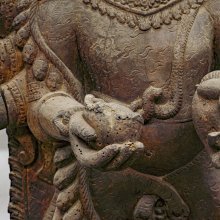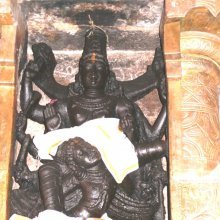Khadga, Khaḍga, Khāḍga, Khaḍgā: 45 definitions
Introduction:
Khadga means something in Buddhism, Pali, Hinduism, Sanskrit, Jainism, Prakrit, Marathi, Hindi. If you want to know the exact meaning, history, etymology or English translation of this term then check out the descriptions on this page. Add your comment or reference to a book if you want to contribute to this summary article.
Alternative spellings of this word include Khadag.
Images (photo gallery)
(+14 more images available)
In Hinduism
Pancaratra (worship of Nārāyaṇa)
Source: Wisdom Library: PāñcarātraKhaḍga (खड्ग, “sword”):—One of the nine symbols representing the cosmic principles of the universe, according to the Pāñcarātra literature. These nine weapons and ornaments symbolize the principles which they represent as the presiding deity. The Sword (khaḍga) represents knowledge.
Source: SriMatham: Vaiṣṇava Iconology based on Pañcarātra ĀgamaThe Sword & Scabbard (khaḍga):—
bibharti yaccāsiratnam acyuto ’tyanta nirmalam |
vidyomayantu tajjñānam avidyākośa saṃsthitam ||“The sword which Śrī Kṛṣṇa possess is the sword of Immaculate Wisdom, The sheath in which it is kept is the sheath of Ignorance.” (V.P. 1;22;73.)
The sword represents Pure Knowledge (jnāna) whose substance is wisdom (vidya)—It is called nandaka which means the ‘source-of-joy.’ This flaming sword is the powerful weapon which destroys ignorance. The sheath represents nescience (avidya) which is the fundamental problem of human existence—ignorance not of data and science but of who we really are in essence—pure conscious entities (jīvas) having a human experience.

Pancaratra (पाञ्चरात्र, pāñcarātra) represents a tradition of Hinduism where Narayana is revered and worshipped. Closeley related to Vaishnavism, the Pancaratra literature includes various Agamas and tantras incorporating many Vaishnava philosophies.
Shaktism (Shakta philosophy)
Source: Wisdom Library: ŚāktismThe Khaḍga (खड्ग, “sword”) is one of the objects Kālī is displayed as holding in one of her hands. It represents discrimination and wisdom.
Source: Google Books: ManthanabhairavatantramKhaḍga (खड्ग) refers to a “swords”, according to the Kulapañcāśikā, an unpublished text attributed to Matsyendranātha teaching secrecy.—Accordingly, “O Hara, why is it that those people who are great heroes devoted to worship and meditation, greedy to drink (the sacrificial) blood—who, well established, carry swords [i.e., khaḍga-hasta] and are devoted, O god, to wandering at night in cremation ground(s)—do not always attain union with the Yoginīs?”.—Note: The Kulapañcāśikā is quoted by Kṣemarāja in his commentary on the Netratantra 8.28 (= Kulapañcāśikā 3.7-8) and on Śivasūtra 3.26 (= Kulapañcāśikā 3.19).
Source: Red Zambala: The 10 Great Wisdom GoddessesThe Khaḍga — sword - represents discrimination and wisdom. Through discriminating between the real and the unreal, the truth and the untruth we gradually progress towards insight and wisdom which culminates in the elimination of the ego. Our spiritual practice does not consist of achieving anything but rather removing those conditioning factors which obscure the vision of the Divine which is our essential, natural state.
Source: Brill: Śaivism and the Tantric Traditions (shaktism)Khaḍga (खड्ग) refers to “(the rite of the) sword”, and formed a part of the Navarātra Tantric ritual (an autumnal festival of the warrior goddess Caṇḍikā).—On Mahāṣṭamī is the worship of the Nine Durgās, [...] rite of the sword (khaḍga-pūjā) in Nepal for powers; [...] Goddess is believed to morph into a more uncontrollable presence requiring constant placation.—Various 8th century sources refer to rituals such as khaḍgapūjā, for example: Devīpurāṇa, Kālikāpurāṇa, Kṛtyakalpataru, Durgābhaktitaraṅgiṇī, Durgāpūjātattva, Durgāpūjāviveka, Bhadrakālīmantravidhiprakaraṇa in Sanderson (2007); account of the Durgā Pūjā in Kelomal, West Bengal (Nicholas 2013).

Shakta (शाक्त, śākta) or Shaktism (śāktism) represents a tradition of Hinduism where the Goddess (Devi) is revered and worshipped. Shakta literature includes a range of scriptures, including various Agamas and Tantras, although its roots may be traced back to the Vedas.
Shilpashastra (iconography)
Source: Google Books: Elements of Hindu iconographyKhaḍga is a sword, long or short, and is used along with a kheṭaka or shield made of wood or hide. The khaḍga is either single-edged or double-edged and has a handle which is not different from the handle of swords seen in the pictures of trhe Crusaders and the early kings of Europe.
Source: Red Zambala: Hindu Icons and Symbols | IntroductionKhaḍga (Sword) - Sword of wisdom which cuts through illusion and destroys all ignorance- hidden within all of us like a scabbard - needs to be withdrawn with skill and used with care and precision.
Source: Shodhganga: The significance of the mūla-beras (śilpa)Khaḍga (खड्ग, “sword”) refers to one of the several “attributes” (āyudha) or “accessories” of a detiy commonly seen depicted in Hindu iconography, defined according to texts dealing with śilpa (arts and crafs), known as śilpaśāstras.—Khaḍga is a sword, long or short, and is used along with a kheṭaka or shield made of wood or hide. The khaḍga is either single-edged or double-edged and has a handle.
Source: Shodhganga: Elements of Art and Architecture in the Trtiyakhanda of the Visnudharmottarapurana (shilpa)Khaḍga (खड्ग) in iconography is associated with Yama, according to the Viṣṇudharmottarapurāṇa, an ancient Sanskrit text which (being encyclopedic in nature) deals with a variety of cultural topics such as arts, architecture, music, grammar and astronomy.—According to the Viṣṇudharmottarapurāṇa the image of Yama should hold a ḍaṇḍa and a khaḍga in his right hands and a carma with one of his left hands. Thus it is clear that the Viṣṇudharmottarapurāṇa offers a great field of knowledge regarding the nuances of Indian art of Image making [e.g., khaḍga] during 10th–11th century A.D.

Shilpashastra (शिल्पशास्त्र, śilpaśāstra) represents the ancient Indian science (shastra) of creative arts (shilpa) such as sculpture, iconography and painting. Closely related to Vastushastra (architecture), they often share the same literature.
Ayurveda (science of life)
Source: Wisdom Library: Āyurveda and botanyKhaḍga (खड्ग) is a Sanskrit word referring to the animal “rhinoceros”. The meat of this animal is part of the māṃsavarga (‘group of flesh’), which is used throughout Ayurvedic literature. The animal Khaḍga is part of the sub-group named Ānupamṛga, refering to animals “who live in marshy land”. It was classified by Caraka in his Carakasaṃhitā sūtrasthāna (chapter 27), a classical Ayurvedic work. Caraka defined such groups (vargas) based on the dietic properties of the substance. According to Monier-Williams, Khaḍga can also refer to a calf with horns half grown
The meat of the Rhinoceros (khaḍga) is obstructing to channels, strength-promoting, sweet, uncting, bulk-promoting and beneficial for complexion. It alleviates fatigue and vāta.

Āyurveda (आयुर्वेद, ayurveda) is a branch of Indian science dealing with medicine, herbalism, taxology, anatomy, surgery, alchemy and related topics. Traditional practice of Āyurveda in ancient India dates back to at least the first millenium BC. Literature is commonly written in Sanskrit using various poetic metres.
Vastushastra (architecture)
Source: Wisdom Library: Vāstu-śāstraKhaḍga (खड्ग):—The Sanskrit name for a classification of a ‘temple’, according to the Agnipurāṇa, featuring a list of 45 temple types. It is listed under the group named Triviṣṭapa, featuring octagonal-shaped temples. This list represents the classification of temples in North-India.
Source: Brill: Śaivism and the Tantric Traditions (architecture)Khaḍga (खड्ग) refers to a “sword” (weapon), according to the Piṅgalāmata (verse 10.93-128).— Accordingly, [while describing the pura on a 9-by-9-plan and the 32 padas]—“At Gṛhakṣata one should set up [a storeroom for] bows, arrows, swords (khaḍga), and other weapons. At Yama there should be a place for ascetics to achieve contemplation of the self. Singers are stationed at Gandharva. At Bhṛṅga is a hall for the exposition [of the śāstras]. Or one may construct a large maṭha on the four [positions] which are Gṛhakṣata and [Yama, Gandharva and Bhṛṅga]”.

Vastushastra (वास्तुशास्त्र, vāstuśāstra) refers to the ancient Indian science (shastra) of architecture (vastu), dealing with topics such architecture, sculpture, town-building, fort building and various other constructions. Vastu also deals with the philosophy of the architectural relation with the cosmic universe.
Purana and Itihasa (epic history)
Source: archive.org: Puranic EncyclopediaKhaḍga (खड्ग).—A warrior of Skandadeva. (Mahābhārata, Śalya Parva, Chapter 45, Stanza 67).
Source: archive.org: Shiva Purana - English TranslationKhaḍga (खड्ग) refers to a “sword”, mentioned as one of the items held in the hands (hasta) of the Goddess (Devī), according to the Śivapurāṇa 2.2.12. Accordingly as Brahmā narrated to Nārada:—“[...] on seeing the mother of the universe cosmic in form, Dakṣa the lord of the subjects considered himself well rewarded. With various sorts of prayer he eulogised and bowed to the Goddess (Devī) mother of the universe, Kālikā seated on a lion, dark-complexioned, with four arms (caturbhuja) and beautiful face, the bestower of the boon, the abode of safety, holding a blue lotus and the sword (khaḍga) in her hands (hasta), comely with reddish eyes and with beautiful dishevelled hair”.
Source: Cologne Digital Sanskrit Dictionaries: The Purana IndexKhadga (खद्ग).—Rhinoceros; flesh very good for śrāddha, but horn to be thrown away.*
- * Vāyu-purāṇa 80. 51.
Khaḍga (खड्ग) is a name mentioned in the Mahābhārata (cf. IX.44.62) and represents one of the many proper names used for people and places. Note: The Mahābhārata (mentioning Khaḍga) is a Sanskrit epic poem consisting of 100,000 ślokas (metrical verses) and is over 2000 years old.

The Purana (पुराण, purāṇas) refers to Sanskrit literature preserving ancient India’s vast cultural history, including historical legends, religious ceremonies, various arts and sciences. The eighteen mahapuranas total over 400,000 shlokas (metrical couplets) and date to at least several centuries BCE.
Kavya (poetry)
Source: Wisdom Library: KathāsaritsāgaraKhaḍga (खड्ग) is the name of a merchant’s son (vaṇikputra) from Dhavala, according to the Kathāsaritsāgara, chapter 56. Accordingly, as Khaḍga said to Cakra: “... I am a merchant’s son named Khaḍga, and because I did not obey the commands of my parents they were angry, and in wrath laid this curse upon me: ‘Because, wicked son, you torture us like a hot wheel placed on the head, therefore such shall be your punishment’”.
The story of Khaḍga was narrated by Candrasvāmin to his son Mahīpāla in order to demonstrate that “one who is cursed by his father and mother does not long enjoy prosperity”.
The Kathāsaritsāgara (‘ocean of streams of story’), mentioning Khaḍga, is a famous Sanskrit epic story revolving around prince Naravāhanadatta and his quest to become the emperor of the vidyādharas (celestial beings). The work is said to have been an adaptation of Guṇāḍhya’s Bṛhatkathā consisting of 100,000 verses, which in turn is part of a larger work containing 700,000 verses.

Kavya (काव्य, kavya) refers to Sanskrit poetry, a popular ancient Indian tradition of literature. There have been many Sanskrit poets over the ages, hailing from ancient India and beyond. This topic includes mahakavya, or ‘epic poetry’ and natya, or ‘dramatic poetry’.
Shaivism (Shaiva philosophy)
Source: Google Books: Manthanabhairavatantram (shaivism)Khaḍga (खड्ग) refers to a “sword” and represents one of the attributes of Svacchanda, according to the Śrīmatottara-tantra, an expansion of the Kubjikāmatatantra: the earliest popular and most authoritative Tantra of the Kubjikā cult. Accordingly, “O goddess, Svacchanda is in the middle, within the abode of the triangle. Very powerful, he has five faces with three times five flaming eyes. [...] O fair lady, my attributes—trident, dagger, sword [i.e., khaḍga], the king of the snakes, and rosary—adorn the right (arms). O beloved, a skull, double-headed drum, javelin, noose and goad—(these) are my divine, brilliant and very auspicious weapons that (are held) in the left (hands). The king of snakes (hangs) on the shoulder and a garland of skulls hangs (from the neck). There is a necklace of scorpions around the throat and the ears are adorned with snakes. [...]”.
Source: Shodhganga: Temple management in the ĀgamasKhaḍga (खड्ग) refers to one of the various Devatā weapons and represents a type of “temple implement (instrument)” as described in the Karaṇalakṣaṇavidhi-paṭala section of the Uttara-Kāmikāgama.—The instruments should be according to the particular śāstra followed at the temple. Some of the instruments mentioned are weapons of all Devatās including [viz., khaḍga].
Source: SOAS University of London: Protective Rites in the Netra TantraKhaḍga (खड्ग) refers to a “sword”, according to the Netratantra of Kṣemarāja: a Śaiva text from the 9th century in which Śiva (Bhairava) teaches Pārvatī topics such as metaphysics, cosmology, and soteriology.—Accordingly, [verse 10.1-7ab, while describing the appearance and worship of Bhairava]—“[...] He] bears a sword and shield (khaḍga—khaḍgakheṭakadhāriṇaṃ), holds a hook and noose. [His] hand[s and posed] in the wish fulfilling and protection [mudrās. He] holds the thunderbolt of a great hero. [He also] holds an axe and a hatchet. Having worshipped Bhairava, [the Mantrin] remembers being joined in union [with] him, [in the same way as] dissolution in fire”.

Shaiva (शैव, śaiva) or Shaivism (śaivism) represents a tradition of Hinduism worshiping Shiva as the supreme being. Closely related to Shaktism, Shaiva literature includes a range of scriptures, including Tantras, while the root of this tradition may be traced back to the ancient Vedas.
Dharmashastra (religious law)
Source: Prācyā: Animals and animal products as reflected in Smṛti textsKhaḍga (खड्ग) or Gaṇḍaka refers to the animal “Rhinoceros” (Rhinoceros unicornis).—The Smṛtis mention several domestic as well as wild animals that are enumerated in context of specifying expiation for killing them, the flesh being used as a dietary article to give satisfaction to the Manes (Pitṛs) in Śrāddha rites, the law of transmigration due to various sins committed as well as in the context of specifying gifts to be given on various occasions. These animals [viz., Khaḍga] are chiefly mentioned in the Manusmṛti, Parāśarasmṛti [Chap.6], Gautamasmṛti [17.2 and 15.1], Śātātapasmṛti [II.45-54], Uśānasmṛti [IX.7-9; IX.12-13], Yājñavalkyasmṛti [I.170-171; I.175; I.258- 260], Viṣṇusmṛti [51.3;51.6;51.26;51.33;80.3-14], Uttarāṅgirasasmṛti [X.15-17], Prajāpatismṛti [Śrāddhatyājyavastuvarṇanam. 138-143], 9 Kāśyapasmṛti [Section on Prāyaścittavarṇanam], Vṛddha Hārītasmṛti [6.253-255] and Kātyāyanasmṛti [27.11].

Dharmashastra (धर्मशास्त्र, dharmaśāstra) contains the instructions (shastra) regarding religious conduct of livelihood (dharma), ceremonies, jurisprudence (study of law) and more. It is categorized as smriti, an important and authoritative selection of books dealing with the Hindu lifestyle.
Jyotisha (astronomy and astrology)
Source: Wisdom Library: Brihat Samhita by VarahamihiraKhaḍga (खड्ग) refers to the “royal sword” [?], according to the Bṛhatsaṃhitā (chapter 2), an encyclopedic Sanskrit work written by Varāhamihira mainly focusing on the science of ancient Indian astronomy astronomy (Jyotiṣa).—Accordingly, “A true Astrologer is also one who has thoroughly mastered the Science of Saṃhitā. [...] It also treats of the prediction of events from the flight of the kañjana and from the appearance of various abnormal phenomena, of expiatory ceremonies; of miscellaneous planetary phenomena; of ghṛta-kambala; of the royal sword [i.e., khaḍga]; of paṭa; of the features of a house cock, a cow, a sheep, a horse, an elephant, a man and a woman. It also treats of the treatment of women; of moles in the body; of injuries to shoes and clothes; of hairy fans; of walking sticks: of beds and seats; of lamplight; of tooth brush and the like”.

Jyotisha (ज्योतिष, jyotiṣa or jyotish) refers to ‘astronomy’ or “Vedic astrology” and represents the fifth of the six Vedangas (additional sciences to be studied along with the Vedas). Jyotisha concerns itself with the study and prediction of the movements of celestial bodies, in order to calculate the auspicious time for rituals and ceremonies.
Yoga (school of philosophy)
Source: ORA: Amanaska (king of all yogas): A Critical Edition and Annotated Translation by Jason BirchKhaḍga (खड्ग) refers to the “(magical) sword”, according to the Brahmayāmala-tantra (or Picumata), an early 7th century Śaiva text consisting of twelve-thousand verses.—Accordingly, [while describing a haṭha-sādhana (foreceful practice)]: “[...] On the eighth day, the Sādhaka sees the shadow of Aghorī. Thus content, she gives [a boon, saying to the Sādhaka], ‘Good, my dear! Choose a boon: either lord of the earth, immortality, levitation, [entry into the] nether-worlds, coming and going through the sky, invisibility, the elixir of mercury, the wish-fulfilling gem, the [magical] sword (khaḍga), the [seven-league] sandals or the [occult] eye collyrium’ [...]”

Yoga is originally considered a branch of Hindu philosophy (astika), but both ancient and modern Yoga combine the physical, mental and spiritual. Yoga teaches various physical techniques also known as āsanas (postures), used for various purposes (eg., meditation, contemplation, relaxation).
Sports, Arts and Entertainment (wordly enjoyments)
Source: archive.org: Syainika Sastra of Rudradeva with English Translation (art)Khaḍga (खड्ग) refers to a “rhinoceros” (which were commonly the victim of hunting), according to the Śyainika-śāstra: a Sanskrit treatise dealing with the divisions and benefits of Hunting and Hawking, written by Rājā Rudradeva (or Candradeva) in possibly the 13th century.—Accordingly, “Hunting on horseback (āśvina) represents one of the eight subdivisions of Hunting (mṛgayā). [...] But something should be said in brief about hunting, for the diffusion of its knowledge. [...] Five or six horsemen are quite enough for hunting rhinoceros (khaḍga-abhisara). The horses should be quiet and well-trained in their motion. A horseman should strike the rhinoceros with small darts in quick succession on the back. [...]”.

This section covers the skills and profiencies of the Kalas (“performing arts”) and Shastras (“sciences”) involving ancient Indian traditions of sports, games, arts, entertainment, love-making and other means of wordly enjoyments. Traditionally these topics were dealt with in Sanskrit treatises explaing the philosophy and the justification of enjoying the pleasures of the senses.
General definition (in Hinduism)
Source: Wisdom Library: HinduismKhaḍga (खड्ग, “sword”):—One of the objects that Yama is displayed carrying. Yama, the vedic God of death, represents the embodiment of Dharma. Yama rules over the kingdom of the dead and binds humankind according to the fruits of their karma.
Source: archive.org: Vedic index of Names and SubjectsKhaḍga (खड्ग) is the reading in the Maitrāyaṇī Saṃhitā of the name of an animal which, in the text of the Vājasaneyi Saṃhitā, variously appears as Khaṅga and Khaḍga. The “rhinoceros” seems clearly to be meant. In the Śāṅkhāyana Śrauta Sūtra a “rhinoceros hide” is mentioned as the covering of a chariot.
Source: Hindupedia: HinduismKhaḍga (खड्ग) literally means “that which cuts”. Sword is a very ancient weapon of duel and war. In iconography, various types of swords have been shown in the hands of the deities. Three types of swords are more well-known:
- karavīrapatra - scimitar
- kulāgra - spear-pointed
- maṇḍalāgra - round-edged
Other varieties like Candrahāsa used by Rāvaṇa and Kṛpāṇa are also mentioned in the texts.
In Buddhism
Tibetan Buddhism (Vajrayana or tantric Buddhism)
Source: Wisdom Library: Tibetan BuddhismKhaḍga (खड्ग) is the name of a Rāśi (zodiac sign) mentioned as attending the teachings in the 6th century Mañjuśrīmūlakalpa: one of the largest Kriyā Tantras devoted to Mañjuśrī (the Bodhisattva of wisdom) representing an encyclopedia of knowledge primarily concerned with ritualistic elements in Buddhism. The teachings in this text originate from Mañjuśrī and were taught to and by Buddha Śākyamuni in the presence of a large audience (including Khaḍga).
Source: Brill: Śaivism and the Tantric Traditions (tantric Buddhism)Khaḍga (खड्ग) refers to the “sword (of wisdom)”, according to the Nāmamantrārthāvalokinī by Vilāsavajra, which is a commentary on the Nāmasaṃgīti.—Accordingly, [while describing Ādibuddha]—“[...] He is tranquil, with the ornaments of a youth, in fine clothing, wearing about himself a many coloured garment. He has eight arms, holding at his heart with four hands the Śatasāhasrikāprajñāpāramitā divided into four parts, [and] carrying, in each of the other four hands, a sword of wisdom (prajñā-khaḍga) in the gesture of striking. [All this is to be] put in place [i.e. visualised] via the yoga of the four Buddha-thrones”.
Source: OSU Press: Cakrasamvara SamadhiKhaḍga (खड्ग) refers to a “sword”, according to the Cakrasaṃvara Samādhi [i.e., Cakrasamvara Meditation] ritual often performed in combination with the Cakrasaṃvara Samādhi, which refers to the primary pūjā and sādhanā practice of Newah Mahāyāna-Vajrayāna Buddhists in Nepal.—Accordingly, “By the form of a skull cup, and by the letter Māṃ, Vāruṇī, Eighteen arms, one face, red color, and three eyes, A sword (khaḍga), arrow and hook, on the right, a skull cup, ax and banner, Thus a mace, thus a bell, and in the ninth, granting wishes, A two-headed drum, a bow and noose, a staff and a water pot, A trident, hammer and lute, and thus a number, in the upper hand, A young adolescent beauty, a great beauty, a beautiful goddess”.

Tibetan Buddhism includes schools such as Nyingma, Kadampa, Kagyu and Gelug. Their primary canon of literature is divided in two broad categories: The Kangyur, which consists of Buddha’s words, and the Tengyur, which includes commentaries from various sources. Esotericism and tantra techniques (vajrayāna) are collected indepently.
Mahayana (major branch of Buddhism)
Source: De Gruyter: A Buddhist Ritual Manual on AgricultureKhaḍga (खड्ग) refers to the “sword (of friendliness)”, according to the Vajratuṇḍasamayakalparāja, an ancient Buddhist ritual manual on agriculture from the 5th-century (or earlier), containing various instructions for the Sangha to provide agriculture-related services to laypeople including rain-making, weather control and crop protection.—Accordingly, [As the afflicted Nāgas said to Bhagavān]: “[...] Then, O Bhagavān, the hostile Nāgas become agitated and destroy crops. [...] They send down excessive rain, a lack of rain and untimely rain. However, O Bhagavān, the spell-master, the reciter of spells, should abide by friendliness. He should have the armour of a friendly being. He should have the sword of friendliness in his hand (maitrī-khaḍga-hasta). [For] friendliness pacifies the hostile”.

Mahayana (महायान, mahāyāna) is a major branch of Buddhism focusing on the path of a Bodhisattva (spiritual aspirants/ enlightened beings). Extant literature is vast and primarely composed in the Sanskrit language. There are many sūtras of which some of the earliest are the various Prajñāpāramitā sūtras.
In Jainism
General definition (in Jainism)
Source: Google Books: Jainism: An Indian Religion of SalvationKhaḍga (खड्ग, “sword”).—One of the fourteen gems (ratna) serving the Cakravartin;—The khaḍga is a sharp sword which breaks all resistance.

Jainism is an Indian religion of Dharma whose doctrine revolves around harmlessness (ahimsa) towards every living being. The two major branches (Digambara and Svetambara) of Jainism stimulate self-control (or, shramana, ‘self-reliance’) and spiritual development through a path of peace for the soul to progess to the ultimate goal.
Languages of India and abroad
Marathi-English dictionary
Source: DDSA: The Molesworth Marathi and English Dictionarykhaḍga (खड्ग).—m (S) A sword. 2 A rhinoceros. 3 A rhinoceros' horn.
Marathi is an Indo-European language having over 70 million native speakers people in (predominantly) Maharashtra India. Marathi, like many other Indo-Aryan languages, evolved from early forms of Prakrit, which itself is a subset of Sanskrit, one of the most ancient languages of the world.
Sanskrit dictionary
Source: DDSA: The practical Sanskrit-English dictionaryKhaḍga (खड्ग).—[khaḍ-bhedane gan Uṇādi-sūtra 1.121]
1) A sword; न हि खड्गो विजानाति कर्मकारं स्वकारणम् (na hi khaḍgo vijānāti karmakāraṃ svakāraṇam) Udb.; खड्गं परामृश्य (khaḍgaṃ parāmṛśya) &c.
2) The horn of a rhinoceros.
3) A rhinoceros; प्रायो विषाण- परिमोषलघूत्तमाङ्गान्खड्गांश्चकार नृपतिर्निशितैः क्षुरप्रैः (prāyo viṣāṇa- parimoṣalaghūttamāṅgānkhaḍgāṃścakāra nṛpatirniśitaiḥ kṣurapraiḥ) R.9.62; Manusmṛti 3. 272,5.18; ... खङ्गशृङ्गं चामरं च (khaṅgaśṛṅgaṃ cāmaraṃ ca) ... Śiva. B.3.12.
-ḍgam Iron.
Derivable forms: khaḍgaḥ (खड्गः).
--- OR ---
Khāḍga (खाड्ग).—a. Relating to a rhinoceros.
Source: Cologne Digital Sanskrit Dictionaries: Edgerton Buddhist Hybrid Sanskrit DictionaryKhaḍga (खड्ग).—(1) nt., a high number (compare khaḍgin): (Ārya-)Mañjuśrīmūlakalpa 262.15 adhikā daśa tare (?) tasya (sc. vivāhasya, compare line 14) khaḍgam ity āhu vāṇijāḥ; 343.14 daśārbudā nirbudaḥ uktaḥ taddaśaṃ khaḍgam iṣyate; (2) m., name of a mountain: Mahā-Māyūrī 254.6.
Source: Cologne Digital Sanskrit Dictionaries: Benfey Sanskrit-English DictionaryKhaḍga (खड्ग).— (probably from kṣad, q. v.; cf. khañj and ) m. 1. A sword, [Rāmāyaṇa] 1, 1, 41. 2. A rhinoceros, [Mānavadharmaśāstra] 3, 272.
Source: Cologne Digital Sanskrit Dictionaries: Cappeller Sanskrit-English DictionaryKhaḍga (खड्ग).—[masculine] sword; rhinoceros.
Source: Cologne Digital Sanskrit Dictionaries: Monier-Williams Sanskrit-English Dictionary1) Khaḍga (खड्ग):—m. ([from] √khaḍ for khaṇḍ?) a sword, scymitar, [Mahābhārata; Rāmāyaṇa] etc. (ifc. f(ā). , [Kathāsaritsāgara])
2) a large sacrificial knife, [Horace H. Wilson]
3) a rhinoceros, [Maitrāyaṇī-saṃhitā iii, 14, 21] = [Vājasaneyi-saṃhitā xxiv, 40] (khaṅga), [Śāṅkhāyana-śrauta-sūtra; Manu-smṛti; Mahābhārata] etc.
4) a rhinoceros-horn, [cf. Lexicographers, esp. such as amarasiṃha, halāyudha, hemacandra, etc.]
5) a Pratyeka-buddha (so called because he is a solitary being like a rhinoceros; cf. eka-cara and -cārin), [cf. Lexicographers, esp. such as amarasiṃha, halāyudha, hemacandra, etc.]
6) Name of an attendant in Skanda’s retinue, [Mahābhārata ix, 2569]
7) of the son of a merchant, [Kathāsaritsāgara lvi, 151]
8) n. iron, [cf. Lexicographers, esp. such as amarasiṃha, halāyudha, hemacandra, etc.]
9) Khāḍga (खाड्ग):—mfn. ([from] khaḍga), coming from a rhinoceros (as armour made of rhinoceros hide), [Śāṅkhāyana-śrauta-sūtra xiv, 33, 20.]
Source: Cologne Digital Sanskrit Dictionaries: Yates Sanskrit-English DictionaryKhaḍga (खड्ग):—(ṅgaḥ) 1. m. A rhinoceros; his horn; a sword, a large knife. n. Iron.
Source: DDSA: Paia-sadda-mahannavo; a comprehensive Prakrit Hindi dictionary (S)Khaḍga (खड्ग) in the Sanskrit language is related to the Prakrit word: Khagga.
[Sanskrit to German]
Sanskrit, also spelled संस्कृतम् (saṃskṛtam), is an ancient language of India commonly seen as the grandmother of the Indo-European language family (even English!). Closely allied with Prakrit and Pali, Sanskrit is more exhaustive in both grammar and terms and has the most extensive collection of literature in the world, greatly surpassing its sister-languages Greek and Latin.
Hindi dictionary
Source: DDSA: A practical Hindi-English dictionaryKhaḍga (खड्ग) [Also spelled khadag]:—(nm) a sword; —[kośa] a sheath; ~[hasta] with a sword in hand, ready to strike.
...
Kannada-English dictionary
Source: Alar: Kannada-English corpusKhaḍga (ಖಡ್ಗ):—
1) [noun] a hand weapon having a long, sharp-pointed blade, with a sharp edge on one or both sides, set in a hilt; a broadsword.
2) [noun] any of large, heavy, thick-skinned, plant-eating, perissodactylous mammals of Rhinocerotidae family of tropical Africa and Asia, with one or two upright horns on the snout; a rhinoceros.
3) [noun] (myth.) one of the eight hells.
4) [noun] (rhet.) a poetry written in the shape of a sword.
5) [noun] (vīr.) a hymn in praise of Vīrabhadra, the promnient destroying power of Śiva.
6) [noun] ಖಡ್ಗ ಹೇಳು [khadga helu] khaḍga hēḷu to praise Vīrabhadra, one of the chief attendants of Śiva, holding a sword in the hand.
Kannada is a Dravidian language (as opposed to the Indo-European language family) mainly spoken in the southwestern region of India.
See also (Relevant definitions)
Starts with (+77): Khadga-grahin, Khadga-raksha, Khadgabahu, Khadgabandha, Khadgabhihata, Khadgabhisara, Khadgabinnana, Khadgacarmadhara, Khadgacarman, Khadgadamshtra, Khadgadana, Khadgadeva, Khadgadhara, Khadgadharavrata, Khadgadhare, Khadgadharin, khadgadharini, Khadgadhenu, Khadgadhenuka, Khadgadrih.
Ends with: Ibbayikhadga, Khadgakhadga, Kutakhadga, Maitrikhadga, Nikhadga, Nyubjakhadga, Prajnakhadga, Sakhadga, Turashatkhadga, Vakrakhadga, Vyalakhadga.
Full-text (+190): Khadgapidhana, Khadgaghata, Khadgamisha, Khadgaputrika, Khadgapatra, Khadgadhara, Khadgakosha, Khadgahva, Khadgika, Khadgaprahara, Khadgamamsa, Khadgamaya, Khadgavidya, Khadgapani, Khadgahasta, Khadgin, Khadgacarmadhara, Khadgi, Khadgaphala, Khadgadhenu.
Relevant text
Search found 46 books and stories containing Khadga, Khaḍga, Khāḍga, Khaḍgā; (plurals include: Khadgas, Khaḍgas, Khāḍgas, Khaḍgās). You can also click to the full overview containing English textual excerpts. Below are direct links for the most relevant articles:
Garga Samhita (English) (by Danavir Goswami)
Verses 6.7.25-26 < [Chapter 7 - The Marriage of Śrī Rukmiṇī]
Verse 6.7.24 < [Chapter 7 - The Marriage of Śrī Rukmiṇī]
Verse 6.7.4 < [Chapter 7 - The Marriage of Śrī Rukmiṇī]
Nitiprakasika (Critical Analysis) (by S. Anusha)
Sarga III: Khaḍga-utpatti-kathana (40 Verses) < [Chapter 2]
Khaḍga (Sword) < [Chapter 3]
Paraśu (Axe) < [Chapter 3]
Shat-cakra-nirupana (the six bodily centres) (by Arthur Avalon)
Summary (of verses 1-13) < [Section 1]
Summary of the Viśuddha Cakra (verses 28-31) < [Section 5]
Verse 7 < [Section 1]
The Skanda Purana (by G. V. Tagare)
Chapter 220 - Importance of Gajacchāyā < [Section 1 - Tīrtha-māhātmya]
Chapter 221 - Things Worthy of Being Offered in Śrāddha < [Section 1 - Tīrtha-māhātmya]
Chapter 83 - Greatness of Yogeśvarī (Yoga-īśvarī) < [Section 1 - Prabhāsa-kṣetra-māhātmya]
Sahitya-kaumudi by Baladeva Vidyabhushana (by Gaurapada Dāsa)
Text 9.37 [Citra-kāvya] < [Chapter 9 - Ornaments of Sound]
Text 9.38 < [Chapter 9 - Ornaments of Sound]
Text 9.38 [sword diagram] < [Chapter 9 - Ornaments of Sound]
Varahi Tantra (English Study) (by Roberta Pamio)
Chapter 12 - The Dhyānas (supports for the meditation) of the Goddess < [Summary of the Vārāhī Tantra]
Chapter 29 - The worship of Caṇḍikā < [Summary of the Vārāhī Tantra]
Chapter 30 - Conclusion of the exposition on Durgāpūjā < [Summary of the Vārāhī Tantra]
Related products
